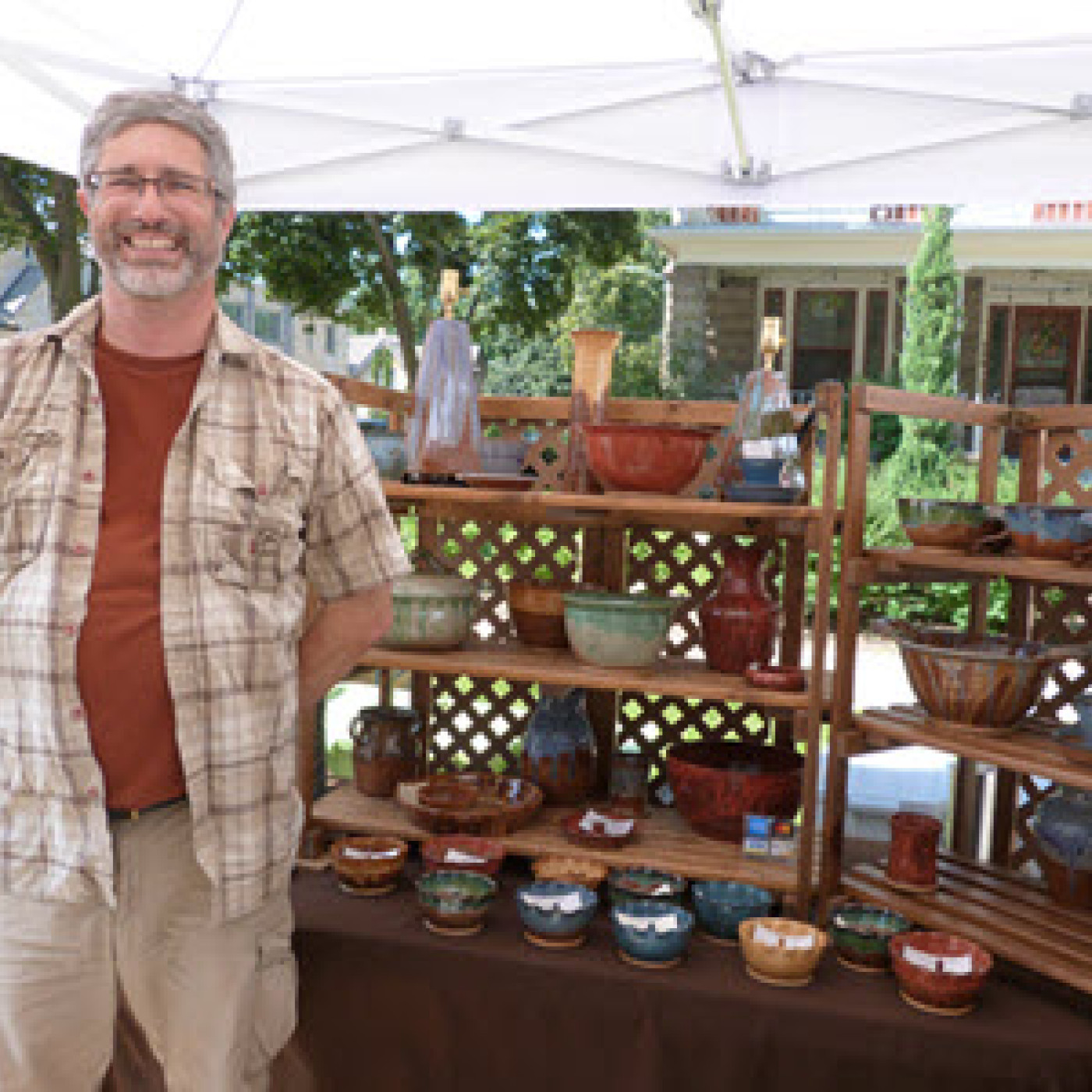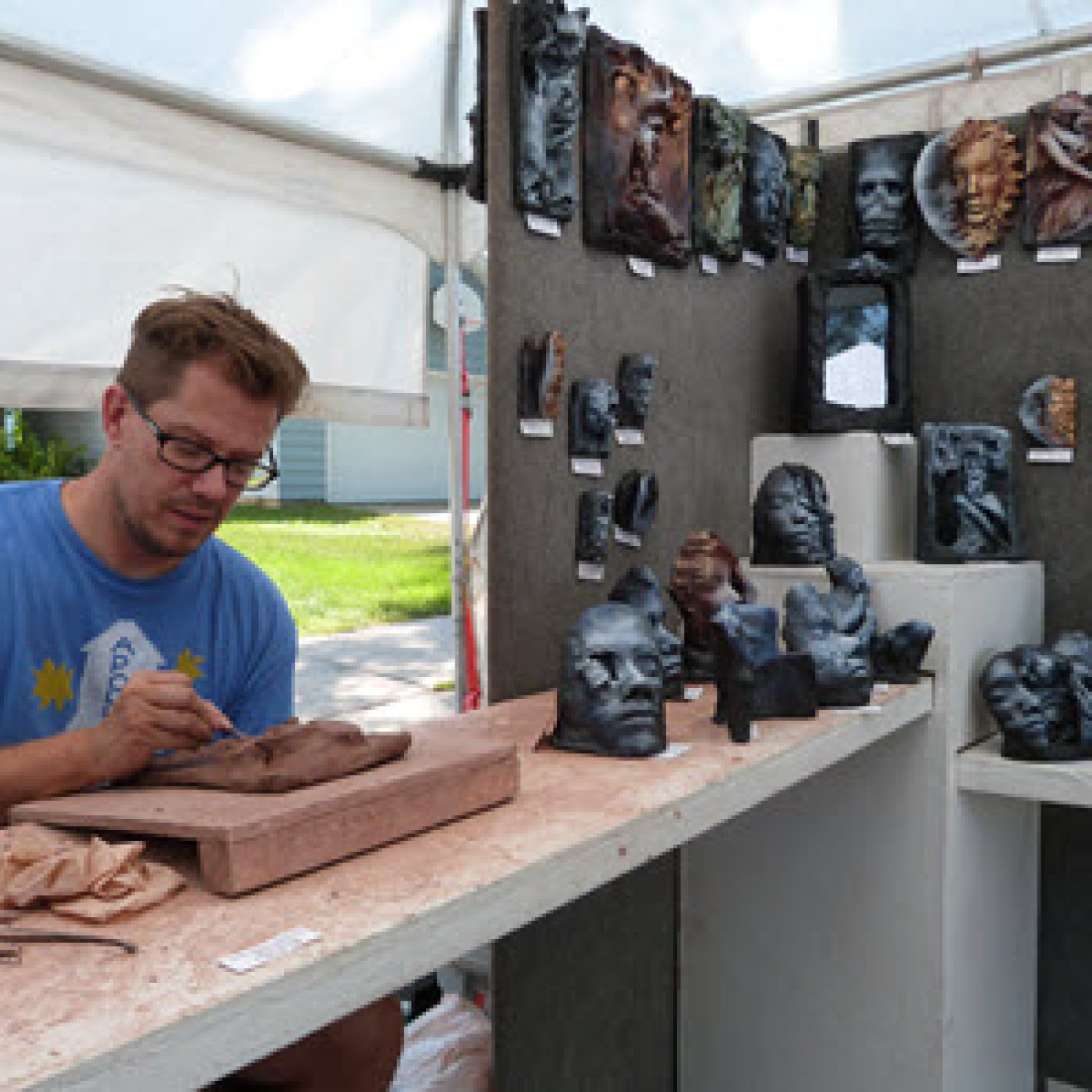Get Ready to Exhibit - How to Prepare After the Pandemic
After a year with few opportunities to exhibit at in-person festivals, artists throughout the country are returning to the show circuit this year. They are seeing additions to events like hand-sanitizer stations and social distancing, but also customers eager to purchase art directly from the hands that made it.
“People are looking for art to uplift and inspire them during these anxious times,” said Natasha Papousek of Poppyfish Studio in San Diego. “People connected with the work I created in response to my own anxiety, especially when I shared those stories.”
Preparation, changes
Papousek attended a show in a gallery that had a mask mandate, lots of alcohol gel sanitizer, and physical distancing rules. She changed how she prepared for it by creating scannable QR codes and posters that had that information on them, so there was less touching of items. She also changed her payment system to touchless credit-card sales.
David Fortenberry also no longer has customers sign anything. “Most, if not all, credit card companies have waived the signature process,” said the fine craft and wood artist.
Mark Zirinsky did not change his payment system, but he did change his criteria for exhibiting at a show. “That is, if I evaluated the show as indifferent to virus-related issues and unreceptive to such concerns, I canceled my exhibition,” said the Denver artist. “To be fair, many of the issues are outside of the show’s control: infection rates, vaccination rates, changing local regulations, the list goes on.” He is looking for top 10 shows with a lot of spacing in between booths and using Centers for Disease Control and Prevention (CDC) guidance and statistics when deciding to either attend or cancel.
Fortenberry attended 10 shows and provided bottles of sanitizer because he lets potential customers try his knives. He sanitizes everything often. Fortenberry noted that “in the beginning of 2021, there was always 6 to 10 feet between booths at every show. Now that seems to be going away, way too early.”
Several artists said they incurred added expenses because of COVID-19. Those expenses included masks, hand sanitizer, QR codes, posters, and individual plastic wrappers for items like cards and prints.

Sunshine Artist Staff Photo
Scott Obernberger of Twice Baked Pottery in Racine, Wisconsin, said he had attended about 20 shows so far this year, including Art at the Park in Appleton, Wisconsin. He said some shows had more space between booths.
His advice to other artists is to have a variety of price points and know their demographics. He knows most of his customers are women between the ages of 30 and 70 who are middle to upper class. Obernberger does Facebook ads in the regions where he is exhibiting at shows and said he gets a lot of customers and sales from that effort.
Ideas for others
Artists offered suggestions for booth layouts that included clear in and out paths, wrapped cards and prints that can be easily wiped down at the end of the day, increased airflow, and 6 to 10 feet of spacing between booths.
“Try to keep some distance between you and people,” said Ann Campbell of Rochester, New York. She had exhibited at a few shows this year and said that one thing she did to make patrons feel comfortable was to have hand sanitizer available. She noted no one used it except her.
Cindi Mapes had not done any shows since March 2020 and said that impacted her greatly. The glass artist lives outside Tucson, Arizona, and had done one show in 2021. “We don’t get to do shows here in the summer,” she said. “My show season — October through March — is my only means of income. I wasn’t able to make money like I would during normal years to get through the summer.”
Mapes wore a mask and had hand sanitizer available when she exhibited this year. Her suggestion for booth layout is to “set up a table in the back, outside of your booth, if you have the space. It makes customers feel more comfortable entering your booth with the extra distance.”
Lessons in 2021
Peggy Schuning, a mixed-media artist in Cincinnati, said she’s made several changes this year. “Since the beginning of 2021, I have mainly chosen to apply for and participate in art fairs which were produced by larger, established art-fair organizers,” she said. “These entities had a track record of organizing art fair/walks during the pandemic and were more likely to occur in person as states were coming out of the pandemic.”
Schuning said this may change how she chooses to schedule art fairs in the future. “It has definitely changed my appreciation for these organizers during difficult times. They were able to create a safe and positive environment that was focused on the art, artists, and event attendees/buyers,” she said.
One thing Zirinsky learned this year that he is incorporating into his work is to “do what you need to in order to protect yourself, moderate your risk with spacing in between booths, and keep airflow going in your booth. Set up your tent as high as it will go to increase airflow and volume. Trust your gut instinct — if you feel uncomfortable, change the circumstances.”
Elizabeth Orleski is a mixed-media artist in New York who said the one thing she learned this year is to “let go of the pressure and thoughts about, ‘What do people want? What can I create that will sell?’ and instead create from being you and what excites you and brings you joy. Someone out there will see you and will appreciate it.”
Changes she made because of the pandemic include focusing on herself and her art. Orleski said her “new ideas used to end up written on scrap pieces of paper. Because of COVID unemployment and isolation, I have time, so I took an idea and actually created something unique. I have a few bins of products and art that are all ready for future shows. Pressure to create is off. That is a good thing.”

Sunshine Artist Staff Photo
Sean Corner’s advice to other artists is to stick with it. “There are going to be good years and bad years,” said the clay sculpture artist from Wichita, Kansas. “I think the shows are going to come back full steam.” Corner expects the fall shows to be great, because everyone is going to want to buy Christmas gifts. “Holiday spending, I think, will be huge this year.”
In Ashburn, Virginia, Daniel Nie said he is making cheerful themes in his art to remind people there are things they can still “celebrate about, even in this difficult world that we are facing.”
Susan Koehler said people are excited to attend shows again and talk to each other. The ceramicist lives in Fairchild, Wisconsin. She has attended about 10 shows so far this year and worked 60 to 70 hours per week for two weeks in July to keep up with the demand for her products. “We just didn’t know — with what happened last year — what this year would be like,” she said. Koehler’s advice to artists preparing to exhibit again is “get ready.”
